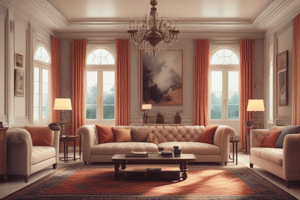Podcast
Questions and Answers
What does an interior design that expresses formality emphasize?
What does an interior design that expresses formality emphasize?
- Complexity, intricacy, and depth
- Casualness, relaxation, and comfort
- Vibrancy, colorfulness, and excitement
- Dignity, reserve, strength, and impressiveness (correct)
What is the primary emotional effect of lines in interior design?
What is the primary emotional effect of lines in interior design?
- Neutrality
- Positive emotional significance (correct)
- Sadness
- Joy
Which element in home planning is considered most important?
Which element in home planning is considered most important?
- Color
- Light
- Form (correct)
- Texture
How much of the total surface area should be covered with a pattern at least?
How much of the total surface area should be covered with a pattern at least?
What is the definition of 'value' in the context of color?
What is the definition of 'value' in the context of color?
What type of colors are red, blue, and yellow?
What type of colors are red, blue, and yellow?
What effect does the use of color have in interior design?
What effect does the use of color have in interior design?
How are secondary colors produced?
How are secondary colors produced?
Study Notes
Interior Design Terminology
- Formality in interior design emphasizes dignity, reserve, strength, and impressiveness through elements like unbroken lines, large spaces, and symmetrical shapes and forms arranged at equal distances from the center.
- Informality in interior design is expressed through modest size, asymmetrical balance, and broken lines.
Elements of Design
- Lines have positive emotional significance and can evoke feelings based on their direction, such as horizontal lines suggesting rest and stability.
- Form is the most important element in home planning, and it should suit its function and be influenced by the material from which it is made.
- Texture refers to the qualities that are perceptible through the sense of touch and gives character and beauty to objects and interiors.
- Pattern refers to surface enrichment and should cover at least 1/4th of the total surface area.
Light and Space
- Light is both an art element and a utilitarian element that evokes emotional effects.
- A sense of beauty and space leads people to desire large undecorated walls and floors, which is why furniture is often minimal and grouped together.
Color
- Color creates depth and is the most powerful tool of a designer, bringing life, beauty, and appeal to a room regardless of cost.
- Color can be seen through reflection off a surface or in colored light sources, and contrasting colors can draw attention to specific parts of an image.
Dimensions of Color
- Hue is the synonym of color.
- Chroma or intensity refers to the brightness or dullness of a color.
- Value refers to the lightness or darkness of a color, ranging from white (lightest) to black (darkest).
Types of Colors
- Primary colors are basic colors obtained directly from nature, including red, blue, and yellow.
- Secondary colors are produced by mixing two primary colors in equal proportion, resulting in orange, green, and violet.
- Tertiary colors are produced by mixing a primary color with a secondary color in equal proportion, resulting in six distinct colors.
Studying That Suits You
Use AI to generate personalized quizzes and flashcards to suit your learning preferences.
Description
Learn about the principles of interior design, including formality and informality, and how they are achieved through elements like line, shape, and space. Understand the emotional significance of design elements and how they contribute to the overall aesthetic.




